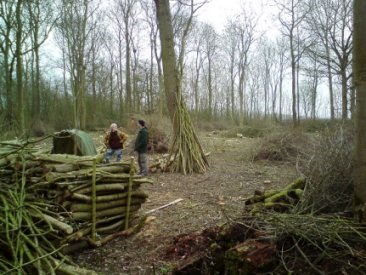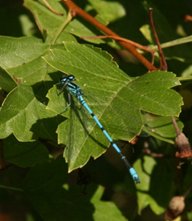Queen Mary's LaneCircular WalkThe Lane's History Queen Mary's March Flora & Fauna Nearby |
Contents

Coppicing
Queen Mary's Wood, which borders Queen Mary's Lane, is a coppice wood. Coppicing is a traditional, sustainable way to harvest firewood, posts, hedging stakes, bean poles and pea sticks, and it is also beneficial to wildlife.
 Here's
how coppicing works:
Here's
how coppicing works:
- Two rides divide Queen Mary's Wood into quarters.
- In 1984, Paul Briscoe & Alfred Whymark first coppiced the south-eastern quarter of the wood.
- This involved cutting down most of the native broad-leaved trees (eg. ash/hazel) in the quarter.
- The tree stumps (stools) formed shoots and re-grew.
- Every five years we move on clockwise round the wood, so that we coppice each quarter every twenty years.
- We leave a few trees standing to encourage the new growth upward toward the light.
- This gives us a renewable supply of wood.
- The aerial photo to the right shows that each quarter is at a different stage of regrowth (Queen Mary's Wood is sometimes called Queen Mary's Covert).
- Over time, the woodland flora and fauna adapt to the cycles of light and shade.
Flower Surveys
When Queen Mary's
Wood started to be
coppiced again in 1984, it was amazing to see the flowers coming up
that had lain dormant in the soil.
Jan/Feb 1984: Paul Briscoe & Alfred Whymark coppiced the south-eastern quarter of the wood. Before that Jack Larter (d. 1975) had not actively managed the wood; trees had merely been coppiced as wood was needed, e.g. for fences, but with no quarterly rotation.
In May 1984 the following flower survey was recorded by the late Gwen Dyke of Farming & Wildlife Advisory Group, Suffolk Committee. And another the following year (probably conducted by Juliet Hawkins, also of Suffolk FWAG).
Jan/Feb 1984: Paul Briscoe & Alfred Whymark coppiced the south-eastern quarter of the wood. Before that Jack Larter (d. 1975) had not actively managed the wood; trees had merely been coppiced as wood was needed, e.g. for fences, but with no quarterly rotation.
In May 1984 the following flower survey was recorded by the late Gwen Dyke of Farming & Wildlife Advisory Group, Suffolk Committee. And another the following year (probably conducted by Juliet Hawkins, also of Suffolk FWAG).
| May 1984 | 1985/...? | |
|---|---|---|
| Wood Avens - Herb Bennet | / | ? |
| Cleavers - Goose grass | / | / |
| Speedwell | / | / |
| Ground Ivy | / | / |
| Common Nettle | / | / |
| Lesser Celandine | / | / |
| Figwort | / | / |
| Bugle | / | / |
| Crosswort | / | ? |
| Common Dock | / | / |
| Red Campion | / | / |
| Hogweed | / | / |
| Plantain | / | / |
| Sowthistle | / | A |
| White Bryony | / | / |
| Silverweed | / | / |
| Sheep's Parsley (Our Lady's Lace) | / | /? |
| Burrweed | / | / |
| Dandelion | / | / |
| Garlic Mustard - Jack by the hedge | / | A |
| Dog's Mercury | / | / |
| Wild Arum | / | / |
| Lesser Stitchwort | / | / |
| Cowslips | / | / |
| Primrose | / | / |
| Creeping Buttercup | / | / |
| Burnet | / | ? |
| Wood sedge | / | / |
| Watercress | / | ? |
| Common Purple Vetch | / | / |
| White Deadnettle | / | A |
| Centaury | / | / |
| Scarlet Pimpernel | / | A |
| Common Thistle | / | / |
| Early Purple Orchid | / | / |
| Marsh Orchid | ? | |
| Brooklime | / | / |
| Creeping Jenny | / | / |
| Meadow Sweet | / | |
| Dog Violet | / | |
| Cinquefoil | / | |
| <illegible> | / | |
| Thistle | / | |
| Willow herb | / | |
| Forget-me-not | / |
|
| Shepherd's Purse | / | |
| Clover | / | |
| Sorrel | / | |
| Rosebay Willowherb | / | |
| Chickweed | / | |
|
Added under heading
'July'
|
||
|
Enchanter's
Nightshade
|
/ | |
|
Lesser
Willowherb
|
/ | |
| No. of species (transcribed not counted) | 38 | 45 |
Bob Briscoe transcribed these surveys in Aug 2012 from a poor copy made on heat-sensitive paper that had been gradually disappearing.
The May 1984 survey recorded by Gwen Dyke was typed. It advises that subsequent surveys should be conducted yearly.
I have tagged the second main survey "1985/..." in the above table, because this text was handwritten in the right margin and the copier had truncated it. It looks like "1985/6y"... but it's not clear. The added flower names had all-but disappeared; the additional ones were hand-written, probably in pencil, onto the May 1984 survey before being copied onto the heat-sensitive paper. Enchanter's Nightshade and Lesser Willow Herb were added separately at the bottom, in different handwriting under the heading 'July'.
The totals are transcribed from the original surveys, even though the number of ticks doesn't add to the totals. Each of the original typed 38 species was marked up in pencil either as '/' (tick), 'A' (presumably meaning 'absent') or '?' (presumably the identification of the specimen was uncertain). The resulting total of species that had been present were totted up to 30, corrected to 31. Then the newly added species were added, totted up to 12, then corrected to 14, which would perhaps account for the extra two found in July, if it meant July 1985. Then a total of 45 was written beneath.

Wildlife Sightings
...coming soon. Recent
Environmental Improvements
Recent
Environmental Improvements
Opening up Queen Mary's Lane has been one of many environmental
improvements we have been undertaking recently. We have:- cleared and dredged several ponds, to let in the light that encourages newts and so forth (including the pond in the middle of Queen Mary's Wood);
- planted 3/4 mile of new hedges to providing corridors for wildlife to move between otherwise disconnected woodland areas (including along the new Queen Mary's Lane);
- thickened up the base of some existing hedges to make a better home for nesting birds, either by coppicing or laying;
- planted 0.7ha of new meadow and sown 3.6ha of field corners with flowers selected for their over-winter seed heads to feed wild birds;
- planted 4.4ha of field margins with tussocky grass and spread them over with clippings rich in wild-flower seeds from Parham's North Green.